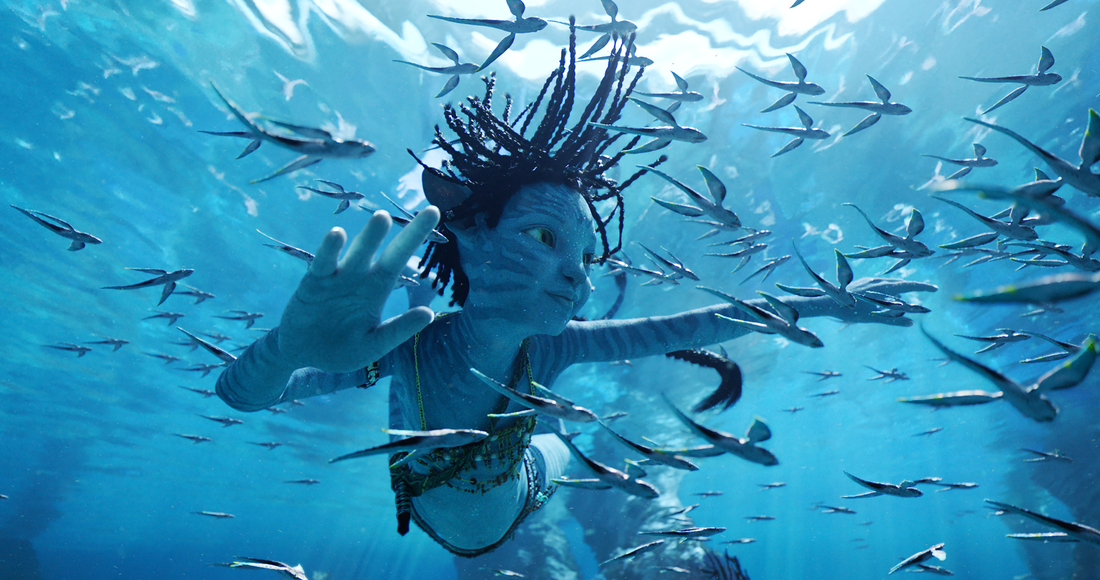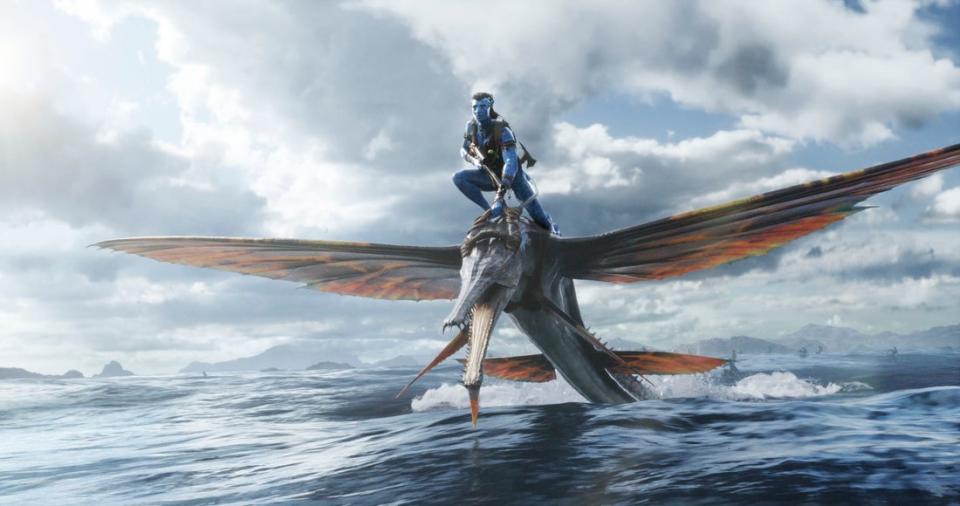‘Avatar: The Way of Water’ Review: James Cameron’s Sequel Is What the Theatrical Experience Was Made for

- Oops!Something went wrong.Please try again later.

To paraphrase a woman once known as Rose DeWitt Bukater: “Outwardly, I’ve spent the last 13 years insisting that only a total moron would ever bet against ‘Avatar’ mastermind James Cameron. Inside, I was screaming.”
Screaming at the idea that modern Hollywood’s most all-or-nothing visionary was going to waste the twilight of his career — and possibly the last gasp of The Movies themselves — on a series of sequels to his least compelling work. Screaming at the notion that the only person with the resources and cachet to create massive new film worlds from scratch had decided to semi-permanently entrench himself in one that I’d already seen and wasn’t particularly itching to revisit. Screaming at the far-fetched prospect that he’d be able to mine fresh pockets of either from a planet that he’d previously (and vividly) terraformed into the most basic of settler-adoption space fantasies.
More from IndieWire
“Aliens,” “Terminator 2,” and even the disavowed “Piranha” sequel prove that Cameron has always had a gift for building radical new sights atop pre-existing bedrock, but I was skeptical that another epic worthy of his ego could be constructed on the bones of such brittle colonization tropes, or that the Na’vi offered him the opportunities he needed to revolutionize movie-going yet again (for better or worse).
On the latter point, of course, Cameron knew that it did. Pandora was conceived as a giant playground for the technology that he wanted to bring to movie theaters — and as the weapon that would force them to go digital or die — and Cameron’s plan for it always extended beyond lithe blue cat people selling the masses on saving the rainforest. His heart belongs to the ocean, after all, and the ones on Pandora are virtually impossible to beat.
Cameron has always treated story as a direct extension of the spectacle required to bring it to life, but the anthropocenic relationship between narrative and technology was a bit uneven in the first “Avatar,” which obscured the old behind the veil of the new where his previous films had better allowed them to intertwine. An out-of-body theatrical experience that makes its predecessor feel like a glorified proof-of-concept, “Avatar: The Way of Water” is such because its spectacle doesn’t have to compensate for its story; in vintage Cameron fashion, the movie’s spectacle is what allows its story to be told so well.
The adventures of Jake Sully (of the Jarhead clan) are probably never going to escape their sub-“Lawrence of Arabia” underpinnings or achieve the kind of popcorn-flavored poignancy that inspired this critic to list “Titanic” as one of the 10 greatest films ever made, but I’ll say this much: When “Avatar” ended, I couldn’t imagine caring about its characters enough to sit through a sequel, let alone four of them. When “The Way of Water” finally ebbed out to sea after 192 spellbinding minutes — receding into darkness with the gentlest of cliffhangers at the end of a third act defined by some of the clearest and most sensationally character-driven action sequences this side of “True Lies” — I found myself genuinely moved by the plight of Jake’s tall blue family, and champing at the bit to see what happened to them next. Never doubted Big Jim for a minute!
Here is a silly movie that works so well because it uses dazzling new tools to satisfy our nostalgia for classic entertainment. Seeing “Avatar: The Way of Water” in 3D VFR at High Dynamic Range doesn’t feel like watching any other movie you’ve seen before. This thing is a categorically and phenomenologically different experience than everything else that’s ever played at your local multiplex, including the original “Avatar” — it’s as many light years removed from the year’s other great blockbusters (“Nope,” “RRR,” and “Top Gun: Maverick”) as the extrasolar moon of Pandora is from Earth.
To some degree, that’s because “The Way of Water” iterates and improves upon technology that’s been tried before. As you would expect from an “Avatar” sequel, the main cast largely consists of 10-foot-tall aliens who mind-meld with nature through the anemone-like tendrils that wiggle out of their braids, only this time the Na’vi look more realistic than most of the human actors you’ll find in other Hollywood fare, especially during the ultra-vivid close-ups that Cameron uses to lend this film an emotional depth that its predecessor lacked the time and technology to achieve.
Like all great sequels, “The Way of Water” retrospectively deepens the original, and while that may not be much of a challenge here, it’s one that Cameron meets all the same. Now that the table-setting is out of the way and paraplegic-marine-turned-alien-clan-leader Jake Sully (Sam Worthington) has been at home in his new world and body for more than a decade, Cameron is free to move beyond $250 million “Pocahontas” fanfic and get a little freaky with the formula.

Courtesy of 20th Century Studios
Jake and his Na’vi huntress mate Neytiri (Zoe Saldaña) have produced four recom/Na’vi hybrid children when the sequel begins, which is enough to suggest that all of the “Avatar” series’ latent horniness is probably a bit less latent when Disney audiences aren’t watching. In fairness, the couple’s least annoying child was adopted when the Avatar that Sigourney Weaver’s Dr. Grace Augustine used during the first movie somehow became pregnant while floating inside its test tube coffin after the scientist’s death.
And while the father’s identity remains something of a mystery, he must have been a pretty cool guy/spirit god because inquisitive teenage Kiri — also played by Weaver in one of the most affecting turns that performance-capture has ever made possible — instantly becomes the series’ best character (the other Sully kids range from “cute” to “under-written middle child” to “oh no it’s basically the idiot son from ‘War of the Worlds’”).
An outcast in a story teeming with them, Kiri depends on a degree of nuance that didn’t seem possible of the Na’vi in the previous film, and the character transcends her “chosen one” mystique with a warmth and curiosity that sets her apart from the rest of the cast, even as her interspecies hybridity and search for belonging find her in good company. She’s the bridge between human and Na’vi, analog and digital, that “Avatar” sorely needed, and her centrality to the next chapter of Cameron’s overarching narrative bodes well for the future of this franchise.
The same can’t quite be said of Miles “Spider” Socorro (Jack Champion), a shredded human teenager who was born on Pandora before the events of the first film, and is so determined to be accepted by/as one of the Na’vi that he runs around in his skivvies with stripes of blue painted over his skin. He’s a Newt for a new generation, and his very old school Cameron-ian goofiness wouldn’t be so worrying if not for the fact that Spider is almost immediately revealed to be the late Col. Quaritch’s son.
Well late-ish, anyway, as the cigar-chomping Quaritch (Stephen Lang) is back in Na’vi form. Earth is uninhabitable, people need a new planet, and a tall blue clone of the genocidal colonist from the last movie is in charge of clearing out the hostiles from humanity’s new home. That nü-Quaritch isn’t human himself adds a curious dynamic to his mission — a wrinkle dramatized by a wonderful “Avatar” take on Hamlet’s “Alas poor Yorick” speech — as does the fact that his own child is fighting alongside the natives.

Courtesy of 20th Century Studios
Whether Spider is a strong enough character to carry that kind of story weight remains to be seen, but the intention alone points the plot towards resonant notes of acceptance and belonging; notes that help “The Way of Water” pivot away from the colonialist overtones that its predecessor wasn’t prepared to handle, and instead towards broader questions about man’s destructive instinct for survival at all costs, in perpetuity, throughout the universe. Quaritch’s war against the Na’vi mirrors the one against his own nature, a war that Jake Sully finds worth fighting in the service of protecting the people he loves and the planet that sustains them.
With Quaritch determined to slaughter Jake’s entire clan in order to put his head on a pike, our hero makes the decision to leave the jungle and flee with his family to the distant atolls of Pandora. That’s where they seek refuge with the sea green Metkayina clan and try to adapt to the life aquatic as they wait for the inevitable third act showdown with Quaritch’s military goons (fingers crossed that Kate Winslet gets more to do in the third movie as the Metkayina’s chief matriarch).
It’s during the film’s leisurely middle stretch that Cameron pioneers the use of underwater performance-capture, which is the kind of thing that only sounds like a big tech bro wank until the moment you see it in action. If parts of the story’s first chapter suggest that audiences are in for a simple retread of a sci-fi adventure that everyone on our planet saw twice and pretends to have forgotten, any “been here, actually do remember this” déjà vu washes all the way off the minute the action finally plunges under the surface and submerges us in an oceanic world so clear and present that you might instinctively start holding your breath.
It’s the most rapturous, awe-inducing, only in theaters return to the cinema of attractions since Godard experimented with double exposure 3D in “Goodbye to Language,” whether swimming with schools of alien fish or introducing us to the four-eyed, 300-foot-long whale-like tulkun (who prove central to the plot and communicate in subtitled Papyrus), these scenes have more in common with VR or lucid dreaming than whatever rinky-dink CGI we’re forced to swallow with every new superhero movie, and Cameron lets us soak up every frame. If we can fall in love with this world and be compelled by the fight to save it, why can’t we do the same with our own?

Courtesy of 20th Century Studios
Complicating the illusion in a way that alternately enhances “The Way of Water” and risks interrupting its flow is a variable frame rate that switches between 24 and 48fps from one shot to the next, as if God (or Eywa) were speed-ramping life itself. There are times when the magic of it all fails to transcend the motion-smoothed memories that may continue to haunt my fellow survivors of “Gemini Man” and “The Hobbit,” and it can seem as if the screen has once again been set to soap opera mode.
There are other times — and your mileage on this will itself prove variable — when it can seem as if there isn’t a screen at all, and that the action is unfolding right in front of you. Either way, almost everything you see looks real (avatar-ized Stephen Lang is the only aspect that caused my brain any cognitive dissonance), or at least it all looks equally unreal, which is the same thing as far as your eyes are concerned.
The experience simply isn’t comparable to whatever else is playing at the local AMC, and yet the most impressive thing about “The Way of Water” might be how it captures the age-old spirit of the multiplex so well that it doesn’t even need to star Tom Cruise. This is a Movie with a capital “M,” its $400 million tech and ecological messaging all in service of a tulkun-sized adventure so transportive that I quickly stopped caring how Cameron made it. It’s certainly always obvious that no one else could have or did, as “The Way of Water” finds new charm in many of the director’s most groan-worthy fetishes and cliches: Stiff heroes, mouth-foaming villains, military jerk-offs, the emasculating insults they spew like bullets (“cupcake,” “buttercup,” other tasty morsels like that), scruffy engineers wearing stupid t-shirts, and enough boomer chutzpah to raise the Titanic are all present and accounted for in unapologetic fashion. Edie Falco walking around in a giant exoskeleton? That’s just a free bonus.
Using cutting-edge technology to recreate something that always seems on the brink of being lost forever, “The Way of Water” effectively marries the “what the hell am I eating?” experience of gastronomy with the full-bellied satisfaction of the first Big Mac you’ve had after a brutal fast. Frustratingly — if also most exciting of all — this feast of a movie left me with the feeling that Cameron is still holding back. Massive and monumental as “The Way of Water” is, there’s little doubt that you’re being served the most expensive appetizer of all time.
Be that as it may, this serving is still more than enough to make your mouth water. By the time the film arrives at its harrowing finale (a sublime reminder that “James Cameron + sinking ships” is one of the best combinations the movies have ever come up with), I couldn’t believe how involved I was by this larger than life cartoon epic about characters I was ready to leave for dead 13 years ago.
Does it matter if “The Way of Water” doesn’t elicit the same response when I watch it at home? Not really — I know that it won’t. Does it matter that Cameron is continuing to “save” the movies by rendering them almost unrecognizable from the rest of the medium? His latest sequel would suggest that even the most alien bodies can serve as proper vessels for the spirits we hold sacred. For now, the only thing that matters is that after 13 years of being a punchline, “going back to Pandora” just became the best deal on Earth for the price of a movie ticket.
Grade: A-
20th Century Studios will release “Avatar: The Way of Water” in theaters on Friday, December 16.
Best of IndieWire
New Movies: Release Calendar for December 9, Plus Where to Watch the Latest Films
Guillermo del Toro's Favorite Movies: 45 Films the Director Wants You to See
Sign up for Indiewire's Newsletter. For the latest news, follow us on Facebook, Twitter, and Instagram.

